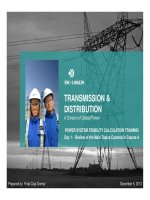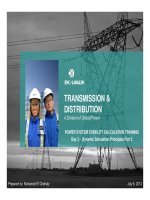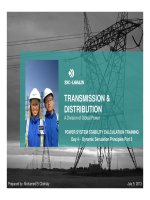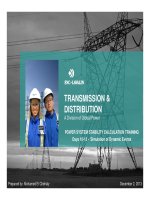Phần 3 KHÓA ĐÀO TẠO TÍNH TOÁN ỔN ĐỊNH VÀ ỨNG DỤNG TRÊN PHẦN MỀM PSSE CHO KỸ SƯ HỆ THỐNG ĐIỆN (Thực hiện tính toán mô phỏng trên Phần mềm PSSE với hệ thống điện 24 nút của IEEE)
Bạn đang xem bản rút gọn của tài liệu. Xem và tải ngay bản đầy đủ của tài liệu tại đây (3.47 MB, 62 trang )
TRANSMISSION &
TRANSMISSION &
DISTRIBUTION
A Division of Global Power
POWER SYSTEM STABILITY CALCULATION TRAINING
Day 1 - Review of the Main Topics Covered in Course A
December 6, 2013Prepared by: Frida Ceja-Gomez
eBook for You
OUTLINE
• Overview of the IEEE 24 Bus System
• Load Flow Analysis
•
N
-
1 Contingency Analysis
2
•
N
-
1 Contingency Analysis
• Short-Circuit Analysis
• PV & QV Analysis
• Dynamic Analysis of 3-ph and SLG Faults
eBook for You
3
IEEE 24 BUS SYSTEM REVIEW
System Components
&
Load Flow Simulation
eBook for You
The IEEE 1996
Reliability Test System
4
SYSTEM COMPONENTS
• Two areas (230kV &
138kV)
• 21 branches
•
10 generators (implicit
•
10 generators (implicit
GSU transformers)
• 20 loads
• 5 two-winding
transformers with
OLTC
• 3 fixed shunts
eBook for You
Running the load flow
simulation
5
• Open the saved case file and
the single line diagram
• Run a power flow simulation;
no errors should be
encountered
LOAD FLOW ANALYSIS
encountered
• Identify the main direction of
the power flow on the SLD
• Use the Limit Checking
Reports to identify overloads
or voltage issues
eBook for You
N-0 Criteria
6
• How did we resolve the
issues encountered in
Course A?
• Transformer
overloads
LOAD FLOW ANALYSIS
overloads
• Low voltages
• Swing machine’s
reactive power limit
exceeded
eBook for You
Eliminating the overloads
7
• All the transforms originally had a rating of 100MVA
• It was necessary to modify the transformers’ ratings as
shown below
LOAD FLOW ANALYSIS
• Note that the resistance/reactance values do not need to
be modified since these parameters were input with
respect to the winding MVA base, which was left
unchanged
eBook for You
Correcting the voltage issues
8
• To address the low voltage at buses 3 and 24,
we added a fixed shunt capacitor of 75 MVAR at
bus 3
LOAD FLOW ANALYSIS
• To address the low voltage at buses 4, 5, 6, 8, 9,
10, 11 and 14, we placed a fixed shunt capacitor
of 115 MVAR at bus 10
• Why did we placed the shunts on the low
voltage side?
eBook for You
Swing bus reactive power
9
• How was this problem corrected?
• To correct this problem, it was necessary to
increase the scheduled voltage at nearby PV buses
LOAD FLOW ANALYSIS
increase the scheduled voltage at nearby PV buses
to encourage other machines to increase their
reactive power output
• Specifically, we modified the scheduled voltage at
bus 23 to 1.03pu
eBook for You
10
IEEE 24 – N-1 CONTINGENCY
ANALYSIS
eBook for You
Preparing the input files for the DFAX file
11
• We had created the subsystem file shown
below, which the whole system as well a
subsystem for each area
N-1 CONTINGENCY ANALYSIS
eBook for You
Preparing the input files for the DFAX file
12
• Also, a monitoring file was created for
• overloads on all branches
•
the buses for each subsystem having a
N-1 CONTINGENCY ANALYSIS
•
the buses for each subsystem having a
voltage below 0.9pu or above 1.1pu
eBook for You
Preparing the input files for the DFAX file
13
• Finally, we wrote contingency file to trip
each of the branches in the system, one at a
time
N-1 CONTINGENCY ANALYSIS
eBook for You
Creating the DFAX file
14
• Go to AC contingency solution (ACCC) and
build the distribution factor data file
N-1 CONTINGENCY ANALYSIS
eBook for You
Creating the DFAX file
15
• Verify the output bar for any problems with
the distribution factor file
•
Note that one of the contingencies isolates a
N-1 CONTINGENCY ANALYSIS
•
Note that one of the contingencies isolates a
bus
eBook for You
AC Contingency Solution
16
• Name the contingency solution output file
and solve
N-1 CONTINGENCY ANALYSIS
eBook for You
AC Contingency Solution
17
• Verify if the
power flow
solution
N-1 CONTINGENCY ANALYSIS
converged for
all
contingencies
eBook for You
AC Contingency Analysis Report
18
• Go to Power
Flow, Reports,
AC Contingency
reports to
N-1 CONTINGENCY ANALYSIS
reports to
generate a report
of the AC
contingency
analysis
eBook for You
AC Contingency Analysis Results
19
• How many contingencies cause line
overloads?
•
How many contingencies overload the
N-1 CONTINGENCY ANALYSIS
•
How many contingencies overload the
transformers?
• How many contingency cause voltage
violations?
eBook for You
AC Contingency Analysis Results
20
• What lines should be upgraded to avoid
major overloads?
•
Where should more lines be built to
N-1 CONTINGENCY ANALYSIS
•
Where should more lines be built to
prevent excessive overloads?
• Is it necessary to add more reactive
power compensation to keep the
voltage within acceptable limits? If so,
where?
eBook for You
Remedial Action Schemes
21
• When it is not possible to add or
upgrade lines, it is necessary to
develop operational measures to
protect lines and other equipment from
N-1 CONTINGENCY ANALYSIS
protect lines and other equipment from
high overloads
• What remedial action schemes would
you implement for the safe operation of
this system?
eBook for You
22
IEEE 24 – SHORT-CIRCUIT
ANALYSIS
eBook for You
Negative and Zero Sequence Parameters
23
• When we built the IEEE 24 Test System,
there was no input data for the zero
sequence parameters
SHORT-CIRCUIT ANALYSIS
• What assumptions can we make when
the negative and zero sequence
parameters are not available?
eBook for You
Negative and Zero Sequence Parameters
24
• Negative-sequence impedance is equal to positive-
sequence impedance for all equipment
• Zero-sequence impedance of generators is equal to ¼
of positive
-
sequence impedance
SHORT-CIRCUIT ANALYSIS
of positive
-
sequence impedance
• Zero-sequence impedance of transformer is equal to
positive-sequence impedance
• Zero-sequence impedance of lines is equal to three
times the positive-sequence impedance (B0 = ½ B1)
eBook for You
Automatic Sequencing Fault Calculation in
PSS®E
25
• Go to the Misc menu,
and select Change
Program Settings
•
Change the short
-
SHORT-CIRCUIT ANALYSIS
•
Change the short
-
circuit output to
Physical and the
coordinates to Polar
• This way, the result of
our short-circuit
analysis will be the
fault current
magnitude and angle
eBook for You









